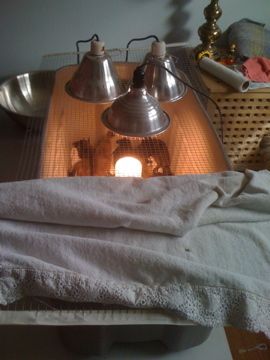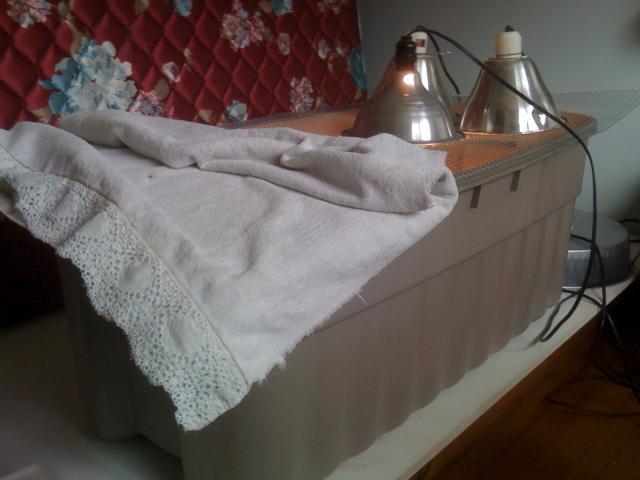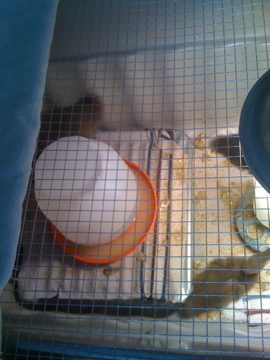Hi!
The aquarium might work, you just want to deal with moisture - keep the aquarium from staying swampy, because too much moisture is conducive to respiratory problems. Good ventilation is needed. Do you have a way to empty *all* the water out of it four or five times a day? Or do you have a waterer platform that will catch all the splash that can be emptied four or five times a day?
I have to watch that with the large tub I am using right now - we will be switching to a taller area with plastic poultry fencing covered with burlap. Meanwhile, I air out the room, keep the bedding as dry as possible (that is now my job - changing bedding to reduce moisture and keep it clean). I am using a broiler pan - slotted top, so the water that spills goes into the lower pan, not the bedding. I put a terrycloth on top, and the waterer on the terrycloth for traction and absorption. Far from perfect, but much better than changing all the bedding every 3 hours or so. I have 15 week-old Indian runners.
Although it seems expensive, I opted for the ceramic heater bulbs that do not make light (they must have a ceramic socket, not a plastic one). Because of a previous project, I had a 30 watt and a 60 watt. I bought a 100 watt because the first week I had trouble keeping the brooder at 90, with the evaporation going on. This week, the ducks seem very comfortable at 80, so I am just using the 30 and 60. As the house warms up and cools down, I add or take away heat lamps, to keep the brooder at a good temperature. I have a round thermometer in there with the ducklings, so I can read it. At least, I can read it if there is not a duckling or mess on the face of the thermometer!
The 100 watt heater bulb raises the room temperature about 20 degrees. So it is relative. If you keep your place cool, like 60, you would only be able to get up to about 80. I can keep the room at 70, so I was able to get the brooder up to 90 when I needed to.
I also have a 60 watt full spectrum bulb, which adds to the heat by about 5 or 10 degrees, but most of the energy is given off as light, so it does not warm the brooder as much as the 60 watt thermal (no light).
Holderread (Storey's Guide to Raising Ducks) recommends 90 F the first week, and dropping 5 degrees a week until they are okay with the outside temperature. I found mine wanted it 90 degrees the first week, but a little cooler this week - between 80 and 85 (very close to his recommendations) - it is going to depend on the birds and the humidity.
The if you use lights, they must be on 24/7, because they are for heat. That is why I like the ceramics - you don't have the birds under strong lights all the time, and I think that while many birds are raised with lights on all the time, I would like mine to be able to have just a night-light overnight, to be more like natural day and night cycles. That is just my own preference.
Dropping 5 degrees a week to 75 degrees is only three weeks. Even though you are in the south, three-week olds don't have their adult feathers yet, are far from grown, and will need extra warmth until they are closer to two months old. While we can say, "look at ducklings in the wild," what many of us are raising are domestic ducks, bred to be cared for by humans in a very different way than wild fowl. Also, many of us forget the mortality number of wild ducklings. If we take extra good care of them while they are young and fragile, they can grow into healthy, hardy adults who can then literally weather many storms with just some basic housing. Some duck people tell us that it is difficult to get their birds in, even in bitter conditions.
I take the approach that I am their caretaker and it is my job to make sure they have what they need to be healthy.
Another thing to work with is just how fast those beautiful babies grow! I think mine are at least three inches taller than they were a week ago. Wow. As they grow, they need more space. Ducklings need exercise to develop properly - enough room for naps is good, but they need to work their legs, too. I am in the process of coming up with Brooder - Part II, because in about a week, perhaps less, the runners will be ready for more room. They are a smallish breed, but still are going to need close to 2 square feet each, just in the brooder.
I have let them swim in the tub - at 90 degrees, in 2 inches of water, with two adults supervising, then after 5 minutes, back into a clean, dry brooder to dry off and stay warm. They don't have fully functioning oil glands (wild ducklings get some oil from their mom). But I read yesterday that allowing them some swim time (mine swim like torpedoes) stimulates their preening glands and preening behavior, which is something that prepares them better for adulthood. It is called wet brooding, and for duck conservation operations, is quite involved. But for me and my little group, it just means getting everyone safely into the warm shallow water for 5 minutes, then back into the warm, clean and dry. Watching them preen has been such fun!
How are you doing for nutrition? Have you decided on starter and grower rations yet?
(By the way, this all starts to come together very quickly, though it may seem like I sent you way more than you were looking for.
)
















